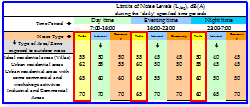Monitoring and Mapping of Traffic Noise and Air Pollution of Arterial Roads in Urban Areas :
A Decision-Assisting Framework for Impact Assessment and Mitigation Measures
Assessment of Noise Levels
The countries of the “Gulf Cooperation Council” (GCC) regulate different aspects of environmental noise. Noise standards and requirements are generally set for both indoor and outdoor environments. These requirements are collectively known as the GCC Noise Standards/Regulations, i.e. "Noise Levels in Indoor and Outdoor Environments in Countries of GCC", April 2006. The noise components of the GCC Noise Standards/Regulations contain limits for determining the compatibility of various land uses with different noise environments. The GCC noise regulations recognize that some receptors are more sensitive to ambient noise levels than others, due to the magnitude of noise exposure (in terms of both exposure time and isolation from noise) and the types of activities/exposure typically involved. Table N1 indicates the maximum allowable received-noise limits for specified land uses described by LAeq, dB(A). The allowable noise limits relevant to traffic noise are highlighted.
Click for Enlarged View
Examining the different sections of the GCC Noise Standards/Regulations, it can be concluded that generally the subjective response to noise level ranges in the environment is as indicated.Should the measured or predicted noise level exceeds the applicable noise levels in any category, then the applicable noise levels must be mitigated so as to equal the acceptable ambient noise levels or lower.

